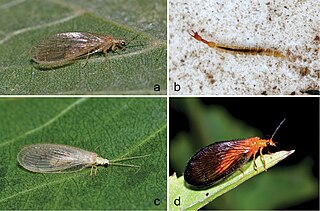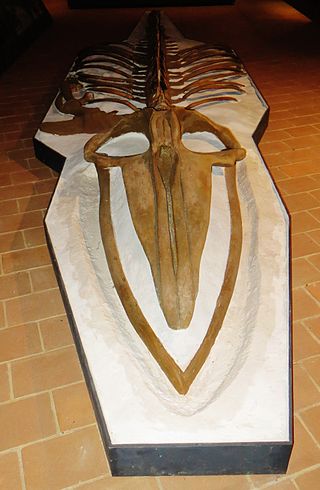
Green lacewings are insects in the large family Chrysopidae of the order Neuroptera. There are about 85 genera and 1,300–2,000 species in this widespread group. Members of the genera Chrysopa and Chrysoperla are very common in North America and Europe; they are very similar and many of their species have been moved from one genus to the other time and again, and in the nonscientific literature assignment to Chrysopa and Chrysoperla can rarely be relied upon. Since they are the most familiar neuropterans to many people, they are often simply called "lacewings". Since most of the diversity of Neuroptera are properly referred to as some sort of "lacewing", common lacewings is preferable.

Entelodon, formerly called Elotherium, is an extinct genus of entelodont artiodactyl endemic to Eurasia. Fossils of species are found in Paleogene strata ranging in age from the Houldjinian until the Rupelian epoch of the early Oligocene.

Snakeflies are a group of predatory insects comprising the order Raphidioptera with two extant families: Raphidiidae and Inocelliidae, consisting of roughly 260 species. In the past, the group had a much wider distribution than it does now; snakeflies are found in temperate regions worldwide but are absent from the tropics and the Southern Hemisphere. Recognisable representatives of the group first appeared during the Early Jurassic. They are a relict group, having reached their apex of diversity during the Cretaceous before undergoing substantial decline.

Mantispidae, known commonly as mantidflies, mantispids, mantid lacewings, mantisflies or mantis-flies, is a family of small to moderate-sized insects in the order Neuroptera. There are many genera with around 400 species worldwide, especially in the tropics and subtropics. Only five species of Mantispa occur in Europe. As their names suggest, members of the group possess raptorial forelimbs similar to those of the praying mantis, a case of convergent evolution.

The Berothidae are a family of winged insects of the order Neuroptera. They are known commonly as the beaded lacewings. The family was first named by Anton Handlirsch in 1906. The family consists of 24 genera and 110 living species distributed discontinuously worldwide, mostly in tropical and subtropical regions. Numerous extinct species have also been described. Their ecology is poorly known, but in the species where larval stages have been documented, the larvae are predators of termites.

The Nevrorthidae are a small family of lacewings in the order Neuroptera. There are 19 extant species in four genera, with a geographically disjunct distribution: Nevrorthus, comprising 5 species with scattered distributions around the Mediterranean; Austroneurorthus, with two species known from southeastern Australia; Nipponeurorthus, comprising 11 species known from China and Japan; and Sinoneurorthus, known from a single species described from Yunnan Province, China. They are traditionally placed in the Osmyloidea, alongside Osmylidae and the spongillaflies (Sisyridae), but some research has considered them to be the sister group to the rest of Neuroptera. The larvae have unique straight jaws that are curved at the tips, and live as unspecialised predators in the sandy bottom sediments of clear, fast flowing mountain rivers and streams. They pupate underwater on the underside of stones. The adults are likely predators or feed on honeydew and other sugar-rich fluids.

Archiinocellia is an extinct genus of snakefly in the family Raphidiidae known from Eocene fossils found in western North America. The genus contains two species, the older Archiinocellia oligoneura and the younger Archiinocellia protomaculata. The type species is of Ypresian age and from the Horsefly Shales of British Columbia, while the younger species from the Lutetian Green River Formation in Colorado. Archiinocellia protomaculata was first described as Agulla protomaculata, and later moved to Archiinocellia.
Hondelagia is an extinct genus of snakefly in the Priscaenigmatidae family. The genus has been described three times under the same taxonomy, but was initially described by A. Bode in 1953. It currently contains one species, the Hondelagia reticulata which was described by Bode in 1953. Its wing is 7 centimetres (2.8 in) in length and 3 centimetres (1.2 in) in width. It was found in Hondelage in Braunschweig. The genus was later described in 1992 by F. M. Carpenter and in 2002 by M. S. Engel. The genus' sister taxa is the extinct Priscaenigma. The species has no sister taxa.
Priscaenigma is an extinct genus of snakefly of the Priscaenigmatidae family which was described by Whalley in 1985. The fossils were found on flatstones at Black Ven in Charmouth, Dorset at 50.7°N 2.9°W in a marine environment of the Charmouth Mudstone Formation. The fossils were collected by J. F. Jackson between 1961 and 1963. Its sister taxa is Hondelagia. The genus contains one species, the extinct Priscaenigma obtusa, also described by Whalley in 1985. Its forewing is 12.6 centimetres (5.0 in) in length. Only a forewing was found when the species was discovered.
Baissoptera is an extinct genus of snakefly in the Baissopteridae family which was described by Martynova in 1961. Since 1961, it has been described three times; Carpenter in 1992, Ponomarenko in 1988 and Engel in 2002. According to J. Jepson et al. in 2011, the parent taxon is Baissopteridae. Fossils of the species have been found in Brazil, China, Spain and Russia.

Mesoraphidiidae is an extinct family of snakeflies in the suborder Raphidiomorpha. The family lived from the Late Jurassic through the Late Cretaceous and is known from twenty-five genera. Mesoraphidiids have been found as both compression fossils and as inclusions in amber. The family was first proposed in 1925 by the Russian paleoentomologist Andrey Vasilyevich Martynov based on Upper Jurassic fossils recovered in Kazakhstan. The family was expanded in 2002 by the synonymizing of several other proposed snakefly families. The family was divided into three subfamilies and one tribe in a 2011 paper, further clarifying the relationships of the included genera.

The Stenophlebiidae is an extinct family of medium-sized to large fossil odonates from the Upper Jurassic and Cretaceous period that belongs to the damsel-dragonfly grade ("anisozygopteres") within the stem group of Anisoptera. They are characterized by their long and slender wings, and the transverse shape of the discoidal triangles in their wing venation.
Iberoraphidia is an extinct genus of snakefly in the family Mesoraphidiidae. The genus is solely known from a Cretaceous, Lower Barremian, fossil found in Spain. Currently the genus is composed of a single species, Iberoraphidia dividua.

Protororqualus is a genus of extinct rorqual from the late Pliocene of Mount Pulgnasco, Italy.

Chresmoda is an extinct genus of insects within the family Chresmodidae.
Paradracaena is an extinct genus of lizards from northern South America. Fossils of Paradracaena colombiana have been found in the Honda Group of Colombia, Peru and Brazil. The species was described as a member of the tegus; Tupinambis huilensis by Estes in 1961.
2017 in paleoentomology is a list of new fossil insect taxa that were described during the year 2017, as well as other significant discoveries and events related to paleoentomology that were scheduled to occur during the year.
2020 in paleoentomology is a list of new fossil insect taxa that were described during the year 2020, as well as other significant discoveries and events related to paleoentomology that were scheduled to occur during the year.
This paleoentomology list records new fossil insect taxa that are to be described during the year 2022, as well as notes other significant paleoentomology discoveries and events which occurred during that year.
This list of 2023 in paleoentomology records new fossil insect taxa that are to be described during the year, as well as documents significant paleoentomology discoveries and events which occurred during that year.










